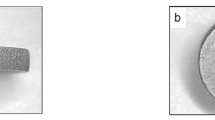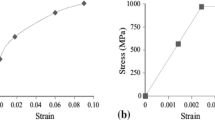Abstract
This article develops a constitutive model for the yield stress of SiC reinforced aluminum alloy composites based on the modified shear lag model, Eshelby’s equivalent inclusion approach, and Weibull statistics. The SiC particle debonding and cracking during deformation have been incorporated into the model. It has been shown that the yield stress of the composites increases as the volume fraction and aspect ratio of the SiC particles increase, while it decreases as the size of the SiC particles increases. Four types of aluminum alloys, including pure aluminum, Al–Mg–Si alloy, Al–Cu–Mg alloy, and Al–Zn–Mg alloy, have been chosen as the matrix materials to verify the model accuracy. The comparisons between the model predictions and the experimental counterparts indicate that the present model predictions agree much better with the experimental data than the traditional modified shear lag model predictions. The present model indicates that particle failure has important effect on the yield stress of the SiC reinforced aluminum alloy composites.











Similar content being viewed by others
References
Cox HL (1952) Br J Appl Phys 3:72
Kelly A (1973) Strong solids. Clarendon Press, Oxford, p 147
Nardone VC (1987) Scr Metall 21:1313
Nardone VC, Prewo KM (1986) Scr Metall 20:43
Taya M, Arsenault RJ (1987) Scr Metall 21:349
Arsenault RJ, Fisher RM (1983) Scr Metall 17:67
Arsenault RJ, Shi N (1986) Mater Sci Eng 81:175
Miller WS, Humphreys FJ (1991) Scr Metall Mater 25:33
González C, Llora J (1996) Scr Mater 35:91
Lewis CA, Withers PJ (1995) Acta Metall Mater 43:3685
Llorca J (1995) Acta Metall Mater 43:181
Maire E, Wilkinson DS, Embury JD, Fougeres R (1997) Acta Mater 45:5261
Withers PJ, Stobbs WM, Pedersen OB (1989) Acta Metall 37:3061
McElro TJ, Szkopiak ZC (1972) Inter Metall Rev 17:175
Sekine H, Chen R (1995) Composites 26:183
Ashby MF (1970) Philos Mag 21:399
Liews CA, Stobbs WM, Withers PJ (1993) Mater Sci Eng A 171:1
Tohgo K, Weng GJ (1994) Trans ASME J Eng Mater Technol 116:414
Lee HK (2001) Comp Mech 27:504
Shimbo M, Naka M, Okamoto I (1989) J Mater Sci Lett 8:663
Brown LM, Clarke DR (1975) Acta Metall 23:821
Song M, Li X, Chen KH (2007) Metall Mater Trans A 38:638
Hong S, Kim H, Huh D, Suryanarayana C, Chun BS (2003) Mater Sci Eng A 347:198
Arsenault RJ, Wang L, Feng CR (1991) Acta Metall Mater 39:47
Dutta I, Bourell DL (1989) Mater Sci Eng A 112:67
Nieh TG, Karlak RF (1984) Scr Metall 18:25
Papazian JM (1988) Metall Trans A 19:2945
Varma VK, Mahajan YR, Kutumnarao VV (1997) Scr Mater 37:485
Acknowledgements
This work was supported by National Natural Science Foundation of China (50801068), PhD Programs Foundation of Ministry of Education of China (200805331044), and Hunan Postdoctoral Scientific Program (2008RS4020). One of the authors would also like to thank the support from Chinese Postdoctoral Science Foundation (200801345, 20070410303).
Author information
Authors and Affiliations
Corresponding author
Rights and permissions
About this article
Cite this article
Song, M., He, Y. & Fang, S. Yield stress of SiC reinforced aluminum alloy composites. J Mater Sci 45, 4097–4110 (2010). https://doi.org/10.1007/s10853-010-4498-0
Received:
Accepted:
Published:
Issue Date:
DOI: https://doi.org/10.1007/s10853-010-4498-0




